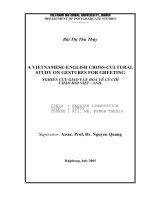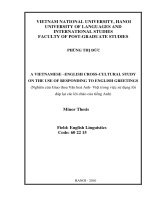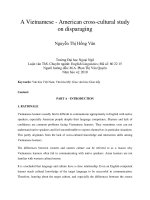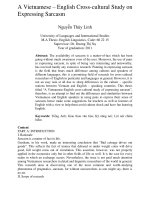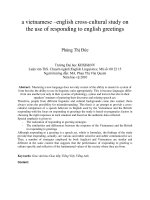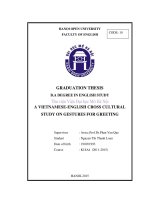A vietnamese – filipino cross cultural study on greetings and responses
Bạn đang xem bản rút gọn của tài liệu. Xem và tải ngay bản đầy đủ của tài liệu tại đây (1.05 MB, 57 trang )
VIETNAM NATIONAL UNIVERSITY, HANOI
UNIVERSITY OF LANGUAGES AND INTERNATIONAL STUDIES
FALCUTY OF POST-GRADUATE STUDIES
CHU THỊ NGỌC
A VIETNAMESE – FILIPINO CROSS CULTURAL STUDY
ON GREETINGS AND RESPONSES
NGHIÊN CỨU GIAO VĂN HÓA VIỆT NAM – PHI-LÍP-PIN
TRONG CÁCH CHÀO HỎI VÀ ĐÁP LỜI
M.A. Minor Thesis
Field: English Linguistics
Code: 60220201
HANOI – 2016
VIETNAM NATIONAL UNIVERSITY, HANOI
UNIVERSITY OF LANGUAGES AND INTERNATIONAL STUDIES
FALCUTY OF POST-GRADUATE STUDIES
CHU THỊ NGỌC
A VIETNAMESE – FILIPINO CROSS CULTURAL STUDY
ON GREETINGS AND RESPONSES
NGHIÊN CỨU GIAO VĂN HÓA VIỆT NAM – PHI-LÍP-PIN
TRONG CÁCH CHÀO HỎI VÀ ĐÁP LỜI
M.A. Minor Thesis
Field: English Linguistics
Code: 60220201
Supervisor: Tô Thị Thu Hương, Ph.D.
HANOI – 2016
TABLE OF CONTENTS
TABLE OF CONTENTS ................................................................................................................i
DECLARATION ............................................................................................................................i
ACKNOWLEDGEMENTS ........................................................................................................... ii
CHAPTER 1: INTRODUCTION ...................................................................................................1
1.1. Research problem and rationale ...........................................................................................1
1.2. Aims of the study ................................................................................................................2
1.3. Significance ........................................................................................................................2
1.4. Scope ..................................................................................................................................3
1.5. Organization........................................................................................................................3
CHAPTER 2: THEORETICAL BACKGROUND..........................................................................4
2. 1. Cross-culture communication .............................................................................................4
2.1.1. Culture .........................................................................................................................4
2.1.2. Communication and Cross-cultural communication ......................................................5
2.2. Definitions of greetings .......................................................................................................5
2.3. Functions and use of greetings .............................................................................................9
2.3.1. Function of greetings ....................................................................................................9
2.3.2. Use of greetings .......................................................................................................... 10
2.4. Review of studies on greetings in English and Vietnamese ................................................ 14
2.5. Factors affecting choice of greetings .................................................................................. 16
CHAPTER 3: METHODOLOGY ................................................................................................ 18
3.1. Research design ................................................................................................................. 18
3.2. Participants ....................................................................................................................... 18
3.3. Data collection .................................................................................................................. 19
3.3.1. Data collection instrument .......................................................................................... 19
3.3.2. Sending consent form and designing questionnaires .................................................... 19
3.3.3. Delivering questionnaires ........................................................................................... 21
3.4. Data analysis ..................................................................................................................... 21
3.4.1. Data analysis instrument ............................................................................................ 21
3.4.2. Data analysis procedure ............................................................................................. 22
4.1. For the first dimension: power distance .............................................................................. 23
4.1.1. For question number 1: Greetings and responses to a director/ manager .................... 23
4.1.2. Question number 2: Greetings and responses to the staffs ........................................... 24
4.1.3. For question number 3: Greetings and responses to a „VIP‟ guest of the company ...... 25
4.1.4. For question number 4: Greetings and responses to a cleaner/ guard of the company . 26
4.2. Dimension gender ............................................................................................................. 27
4.3. Dimension age: Greetings and responses to an older or a younger student .......................... 29
CHAPTER 5: CONCLUSION ..................................................................................................... 35
5.1. Major findings of the study ................................................................................................ 35
5.1.1. Greetings and responses to director/ manager ............................................................ 35
5.1.2. Greeting and responses to the staffs in the company .................................................... 35
5.1.3. Greetings and responses to a cleaner/ guard ............................................................... 36
5.1.4. Greetings and responses in other cases ....................................................................... 36
5.2 Limitations ......................................................................................................................... 38
5.3. Suggestions ....................................................................................................................... 38
APPENDIXES ............................................................................................................................... I
APPENDIX B ...............................................................................................................................III
LIST OF COMPANIES PARTICIPATING IN THE STUDY .......................................................III
APPENDIX C .............................................................................................................................. IV
QUESTIONNAIRES FOR ........................................................................................................... IV
VIETNAMESE – FILIPINO CROSS-CULTURAL STUDY ON GREETINGS AND RESPONSES
IN BUSINESS ............................................................................................................................. IV
DECLARATION
I certify that the work contained in this thesis is the result of my own research, and
this thesis has not been submitted for any degree at any other university or
institution.
Hanoi, November 2016
Signature
Chu Thi Ngoc
i
ACKNOWLEDGEMENTS
First and foremost, I would like to express my deepest gratitude to my supervisor,
Ph.D. To Thi Thu Huong, who gave me enthusiastic instructions, patient guidance
and precious comments throughout the process of carrying out this study. Had not
been for her valuable support and her encouragement, I would not have finished my
research.
My sincere thanks are also to those working in companies in The Philippines as
well as in Vietnam for their constructive comments as well as their participation
which was essential to the completion of the study.
Last but not least, I want to send my gratefulness to my family and my friends who
have encouraged and support me during the process of doing this study.
ii
ABSTRACT
This research focuses on finding out what Filipino and Vietnamese working in
companies often say to greet and respond in daily conversations. The framework
used in this study was built mainly based on Hofstede‟s but with some adaptation;
therefore, only four dimensions were applied to gain data. The four dimensions
applied were power distance, gender, age, and acquaintance. Despite some minor
differences, there were mostly similarities were found between answers from
participants in two countries in particular situations.
iii
LIST OF FIGURE AND DIAGRAM
Figure 1: Hofstede‟s cultural dimensions
Diagram 1: Laver‟s diagram of the Factors that Constrain the Choice of Formulaic
Greeting Phrases in British English
Table 1: A summary of greetings and responses to a director/ manager
Table 2: A summary of greetings and responses to the staffs
Table 3: A summary of greetings and responses to a „VIP‟ guest
Table 4: A summary of greetings and responses to a cleaner/ guard
Table 5: A summary of greetings and responses to an older colleague
Table 6: A summary of greetings and responses to a younger colleague
Table 7: A summary of greetings and responses to a male colleague
Table 8: A summary of greetings and responses to a female colleague
Table 9: A summary of greetings and responses to a first meeting colleague
Table 10: A summary of greetings and responses to a well-known colleague
Table 11: A summary of commonly used topics
iv
CHAPTER 1: INTRODUCTION
This chapter aims to provide with the most general information about what is
included in the study and how it is carried out.
1.1. Research problem and rationale
Nowadays, the tendency of studying abroad is becoming more and more popular.
Many Vietnamese students have been taking courses in famous universities in
English-speaking countries like England, The United States, and Australia. There
also appears a trend of coming to some Asian countries where English is spoken as
an official language such as Singapore, The Philippines.
As a country of the Southeast Asian area, The Philippines is the country that has
quite a close relationship with Vietnam. Especially, in the globalization trend and
the process of building an Asian Economic Community, the understanding of the
countries in this area is really necessary. However, The Philippines has been
familiar with most of Vietnamese only through some films or occasionally-held
cultural exchanging programs. Although English is spoken widely in The
Philippines, the ways the Filipino use English may be different from that people in
other English speaking countries due to distinguished cultural features. Besides,
there have not been many studies on relationship between the Vietnamese and the
Filipino culture. Deep understanding is even more essential for students who want
to learn and people who want to do business in The Philippines and work with the
Filipino, and vice versa. Ferraro & Briody (2006) also cited what had been proved
by other scholars about the importance of cultural understanding that „failures in the
global business setting – including partnerships and joints ventures – most frequently
result from an inability to understand and adapt to foreign ways of thinking and acting
rather than from technical or professional incompetence‟ (Black, Gregersen, and
Mendenhall (1992), Adler (2002); Thomas (2007); Maurer and Li (2006)).
1
From those above mentioned reasons, the study was conducted under the title ‘A
Vietnamese – Filipino cross – cultural study on greetings and responses’ with the
hope to find out the similarities as well as the differences in greetings and responses
frequently used in these two languages, which is the very first cultural matter people
should know when trying to understand a country and a culture. This study paid
more attention on how people working in companies greet each other verbally from
the cultural approach.
1.2. Aims of the study
This study is conducted with the hope to make some comparisons between the ways
Vietnamese and Filipino people greet each other, especially among those working
in companies. Main focus is going to be put on verbal language in the business
circumstance. The results of this study may be useful for any Vietnamese student
who wants to take a business course in The Philippines; or for the Filipino who
want to study, travel or do business in Vietnam. Besides, the findings in this study
can be used as a reference for other researchers who have interest in language or
culture field.
To implement these aims, these three following questions will be used:
1. What are the common greetings and responses in English used by Filipino
businessman in the company?
2. What are the common greetings and responses in Vietnamese used by
Vietnamese businessman in the company?
3. What are similarities and differences in greetings and responses in these
two languages?
1.3. Significance
This study, on the one hand, hopes to provide the Vietnamese students‟ knowledge
of the greetings and responses that the Filipino and the Vietnamese working in
companies often use in their everyday business contacts; therefore, they can not
2
only widen their background knowledge but also make a careful preparation for
their learning abroad and future working plans.
On the other hand, enterprises probably find the findings of the study useful in their
plan of doing business in Vietnam or in The Philippines.
Moreover, as there has not been any research in investigating this issue yet, the
research wishes to bring Filipino and Vietnamese people closer through their deeper
understanding in culture. Hence, people from these two countries can get benefits in
educational, economic and cultural exchanges.
1.4. Scope
The study is going to compare the phrases of Vietnamese and Filipino greetings
made by businessmen and staffs in their companies to see the similarities as well as
the differences. Here, the Filipino greetings and responses are delivered in English
while Vietnamese is used in Vietnam.
1.5. Organization
The main body of this thesis consists of five chapters:
Chapter 1: Introduction: presents the rationale, the aims, the significance, the
scope and the design of the study. The research questions are also raised in this
chapter.
Chapter 2: Theoretical background: provides the definition of major related
concepts and reviews the related works that compose the theoretical background of
the study.
Chapter 3: Methodology: gives a more detailed description of methodology used.
Who took part in, which method was used to collect and analyze data.
Chapter 4: Findings and discussion: demonstrates the results after analyzing the
collected data and gives brief summary answer for the research questions.
Chapter 5: Conclusion: summarizes the whole research, gives some implications,
and discusses the limitations of the study as well as suggestions for further research.
3
CHAPTER 2: THEORETICAL BACKGROUND
This chapter introduces the different definitions of greetings and its functions.
Moreover, this chapter will provide a deeper insight into the common greetings and
responses used by Vietnamese and Filipino.
2. 1. Cross-culture communication
2.1.1. Culture
There are hundreds of definitions of culture from different approaches. The writer
found that Mahadi (2012) cited a series of different definitions of culture. He quoted
Roohul-Amini‟s definition (1989) that "culture has multifarious meanings. Culture
meant farming" (p. 15). From the sociological perspective, culture is the total of
the „inherited and innate ideas, attitudes, beliefs, values, and knowledge,
comprising or forming the shared foundations of social action‟. Likewise, from the
anthropological and ethnological senses, culture „encompasses the total range of
activities and ideas of a specific group of people with common and shared
traditions, which are conveyed, distributed, and highlighted by members of the
group‟ (Collins English Dictionary 1991, 1994, 1998, 2000, 2003). Edward Sapir
(1956) considered culture as „a system of behaviors and modes that depend
on unconsciousness‟. Whereas, Rocher (1972, 2004), an anthropologist, believes
that „culture is a connection of ideas and feelings accepted by the majority of
people in a society‟ (p. 142). Undeniably, culture is learned and shared within
social groups and is conveyed by non-genetic ways (The American Heritage,
Science Dictionary 2005).
On the other hand, Hofstede‟s opinion of culture (2005) stated that „culture consists
of the unwritten rules of the social game. It is the collective programming of the
mind that distinguishing the members of a group or category of people from others‟
(p.3). He also claimed the elements of cultures consist of values, beliefs, and
material products.
4
2.1.2. Communication and Cross-cultural communication
According to Business dictionary, „communication is a two-way process of reaching
mutual understanding, in which participants not only exchange information, news,
ideas and feelings but also create and share meaning‟. In other words,
communication is considered as a means of connecting people or places. In
business, it is „a key function of management – an organization cannot operate
without communication between levels, departments and employees‟.
According to Krauss (2002), verbal communication often used signs and symbols
and it was the symbolic content of verbal communication that decided the
extraordinary effectiveness. He also stated that language is only one of the symbol
systems which are employed in human communication.
Cross-cultural communication, also known as intercultural communication, is „the
sending and receiving of messages across languages and cultures. It is also a
negotiated understanding of meaning in human experiences across social systems
and societies‟ (cited by Arent (2009)). In the globalization, awareness of cultural
diversity become more and more necessary to help people avoid misunderstanding
and achieve communication purposes.
2.2. Definitions of greetings
Greetings are an important part of the communicative competence for being a
member of any speech community. „They are often one of the first verbal routines
learned by children and certainly; one of the first topics introduced in foreign
language classes‟ (Duranti (1997, p.188). There are numerous definitions of
greetings from different approaches such as ethnology, linguistics, sociology and
ethnography, some of which were mentioned in this study.
In the Cambridge dictionary, greeting is „something friendly or polite that you say
or do when meet or welcome someone‟. In plural, it is „a message that says you
hope someone is well, happy, etc.‟
Being investigated by another researcher, Firth‟s viewpoint as cited in Li‟s study
(2010), greetings were „a system of signs that convey other than overt messages‟.
5
This can be understood that when greeting a person, the speaker can use both verbal
and non-verbal language to convey the message.
In one linguistic journal, Duranti (1997) reintroduced the definition of greetings by
Firth (1972) and Goffman (1971) in ethological field that greetings in all societies
were about continuity of relationships, but they said that the representation,
conceptualization, and perception of continuity by humans seemed to be more
complex than that found in other species.
In another way of accessing definition of greetings, Williams (2001) reviewed on
greeting exchanges from three perspectives: at micro level was linguistic aspect
which focused on linguistic behavior, from sociolinguistic aspect which looked
more at social interaction and at a broader level which interpreted the linguistic
behavior of greetings along with interaction as representing culture.
As being cited by William (2001), from the first point of view, linguistic definition
introduced by two linguists, Schegloff and Sacks (1973), saw greetings as „a speech
event composed of two parts side by side, serial, and sequential‟ such as GreetingGreeting: (A: Hi
B: Hi) Or greeting- request for information (A: Hi
B: Do you
have a class today?).
Whereas, in the sociolinguistic approach, the famous sociolinguists Goffman
(1971), saw greeting exchanges as „access rituals‟ consisting of two kinds, passing
greetings and engaging greetings. In general, greetings were defined as „consisting
of several interlinking behaviors: Verbal, non-verbal, term of address and social
context‟. Besides, greeting phenomenon was referred to as ritual with verbal form
(may be one of three linguistic units: question („How do you do?), interjection
(„Hello‟) or affirmation („Good morning‟)) and non-verbal form (composed of body
language).
Lastly, in anthropological linguistics approach, greetings were defined by Fieg and
Mortlock (1989) as “ritualistic expressions” which are affected by social factors,
particularly cross-cultural differences (as cited in Williams, 2001).
6
To sum up, each definition accessed to „greetings‟ from one aspect so that they gave
us multi-dimensional review on this concept. Depend on the studying approach,
particular ways of defining „greetings‟ should be applied. The researcher finds the
latest definition of Goffman (1971) the most suitable with what are going to be dealt
with in this research. Hence, the study will be able to investigate how people in two
cultures greet each other using verbal language, based upon different social factors,
especially among people in business context.
In English, especially in business, people often use formal ways to greet each other.
There are some common ways like
- A: „How do you do‟ - B: I‟m doing well (very formal),
- A: „How have you been?‟ - B: talk about their current life (people who have
already met)
- A: „It‟s nice to meet you‟ or „Pleased to meet you‟ (for the first time meeting)
B: Me, too./ Pleased to meet you.
- „Good morning/ good afternoon/ good evening‟
People can also use casual greetings like „hello/ hi‟ or use small talks:
- A: „How are you?/ how are things?‟… - B: Good/ not bad/ Fine, thanks, and
you?...
- A: „What‟s up?/ what‟s new?/ What‟s going on?‟,… - B: Nothing/ not much (more
than asking about wellness). What‟s about you?
- A: How‟s it going? / How are you doing?... – B: It‟s going well/ I‟m doing well.
How about you?
- A: Long time no see (what‟s new?) - B: Long time no see,
For The Philippines, they are the third largest group of English speaking people in
the world, after the United States and the United Kingdom. Nolan (1996) once
claimed that the Filipino style and tone of business had much difference from that in
New York or London although plenty of Philippine business practices follow
international models.
7
On the other hand, in a journal about this issue by Yaw Sekyi-Baidoo & Louisa A.
Koranteng (2008), the Achebe‟s (1976) and Owusu-Ansah‟s hypothesis (1994) was
applied. Those authors concluded that English general greetings used in a different
(non-native) cultural context composed of not the same ethnographic factors
perhaps resulted in different forms as well as pragmatic meanings from what
belonging to native context. Hence, it can be inferred that although English is used
in The Philippines as an official language, the use may be varied.
In particular, Filipino also address superiors with the English „sir‟ or „ma‟am‟ in
business context and find uncomfortable with a more informal approach. The word
„po‟ meaning „sir‟ is added when talking to a superior or to an elder no matter
which gender he or she is. In spite of this, Filipino show their respect to all without
concerning station, superior or subordinate relationship to address their partner.
Colleagues are said to be addressed by the first name. Mr., Mrs., or Miss or the titles
such as Dr. (doctor), Engr. (engineer). Those greetings may be accompanied with
non-verbal greetings such as „a hug and kiss between close female friend, holding
hand between male friends, making eye contact, raising and lowering their
eyebrows‟ („Cultural clues, do‟s and taboos: Communication guidelines for the
Philippines‟)
In Vietnam, greetings is considered an indispensable and important part in their
everyday life. Vietnamese greet each other not only to welcome but also to establish
and maintain relationship with people surrounding. According to Vietnamese
dictionary (2013), to greet means to speak or use actions to show one‟s respect and
closed behavior. There are two types of greetings in Vietnamese: direct and indirect
greetings.
In the first type, direct greetings are used to open or to end a meeting to express
polite, modest and gentle behavior of speakers (Phạm Thị Thành, 1995). They often
have the structures such as
-
Chào Sp2.
-
Chào Sp2 ạ!
-
Sp1 chào .Sp2
8
-
Sp1 chào Sp2 ạ!
They all include the word „Chào‟ and sometimes the word „ạ‟ at the end of the
greetings to show respect to the listener. This structure is different from that in
English in which greetings missing subject or modality. On the other hand, this
feature is created because Vietnamese want to create closed relationship between
speakers.
In the second type of greetings in Vietnamese, indirect greetings are represented by
more forms and used more frequently. Hence, this type shows Vietnamese typical
features of traditional values. Indirect greetings may use questions about health,
family or hometown to greet, for instance:
„Khỏe không?‟ („How are you?‟) or „Công việc dạo này sao rồi?‟ (How‟s your
work?‟);
Indirect greetings can also use calling exclamations such as Ô, chị! („Oh, you‟!), A,
mẹ đã về! („Ah, you‟re here, Mom‟)
Or congratulation such as Chúc mừng bạn! („Congratulation!‟), or invitation like
„Mời bác vào xơi cơm ạ‟ (have lunch/ dinner with us‟); or even comments like „Ai
mà diện thế nhỉ?‟ (Who is this beautiful girl?‟).
In the cities nowadays, instead of asking like „bác đi đâu đấy?‟ (where are you
going?) or „bác ăn cơm chưa?‟ (have you had lunch?), people working in offices or
companies tend to greet their colleagues by asking about health or the status of job.
Responding to those greetings are answers from the listener. Similar to situation in
The Philippines, Vietnamese can simply perform non-behavior actions like
nodding; handshaking or a question or thanking to the aforementioned greetings. In
some cases, the younger may bow to greet the older when greeting.
2.3. Functions and use of greetings
2.3.1. Function of greetings
Greetings is the very first thing to appear in a conversation. Greetings was
considered as the first step to „establishing rapport‟ (Pachter, 2013). According to Li
(2010), greetings was considered under different aspects. First of all, when viewing
in pragmatic viewpoint, Li (2010) chose to follow the idea that greetings could be
9
regarded as illocutionary acts (Austin‟s theory and it belonged to category of
„expressive‟). This means that greetings should not be understood literally. Besides,
Li (2010) treated greetings as linguistic routines of politeness. From this viewpoint,
he chose to follow Brown and Levinson‟s politeness theory to explain the function
and use of greetings. According to the two authors, greetings were restricted by
social factors (adapted from model of Laver J. (1981) cited in Qian (1996)) and
would be guided by polite norms in certain cultures.
2.3.2. Use of greetings
2.3.2.1. Hofstede’s cultural dimensions
In business context, the Hofstede‟s cultural dimensions (1972) have been applied
and cited in many studies especially ones in business marketing. The six dimensions
he investigated were power distance, individuality, masculinity versus femininity,
tolerance of uncertainty, and long term versus short term.
Figure 1: Hofstede’s cultural dimension model (1972)
a. Power distance
The power distance dimension can be defined as „the extent to which less powerful
members of a society accept and expect that power is distributed unequally‟. In
10
large power distance cultures, everyone has his or her rightful place in a social
hierarchy. Further, „the colder the climate, the smaller the power distance‟.
According to Hofstede‟s study result conducted originally in 1972, the Philippines
got 94 points for power distance index (0 – 100 points). This means that in The
Philippines, the awareness of power distance is quite obvious and they are a
hierarchical society. Similarly, in Vietnam, a hierarchy country (score of 70), the
concept of power distance is also common among people. Hofstede considered
hierarchy in an organization as a factor reflecting inequality, „subordinates are
supposed to be told what to do and the ideal boss is a benevolent autocrat‟.
b. Individualism
It can be defined as „people looking after themselves and their immediate
family only, versus people belonging to in-groups that look after them in exchange
for loyalty‟. In other words, the fundamental issue addressed by this dimension is
„the degree of interdependence a society maintains among its members‟.
The Philippines got 32 points for this dimension. It can be inferred that this country
is collectivism oriented. This is manifested in a close long-term commitment to the
member group, be that a family, extended family or extended relationships. The
relationship between employer and employee is recognized in moral terms (similar
to a family link), which to some extents, are the same as that practice in Vietnam
society (score of 20).
c. Masculinity
The dominant values in a masculine society are achievement and success; along with
quality of life, caring for other people is the values which domain in a feminine society.
The main issue in this dimension is „what motivates people, wanting to be the best
(Masculine) or liking what you do (Feminine)‟.
For this dimension, the score of the Philippines is 64 scores. It can be inferred from
this rank that this society is a masculine society. Whereas, Vietnam scores 40 on
this dimension and was said to be a „Feminine‟ country according to Hofstede‟s
definition. In such masculine countries, Hofstede pointed out that people „live in
11
order to work‟. People in such kind of society emphasize equity, and solve
competition, performance and conflicts by fighting them out. On the contrary, in
feminine countries like Vietnam, people „work in order to live‟; therefore, instead of
being decisive and assertive, managers in a feminine society strived for agreement
and equality. Besides, Vietnamese are thought to pay more attention in solidarity
and quality.
d. Uncertainty avoidance
This dimension can be defined as „the extent to which people feel threatened by
uncertainty and ambiguity and try to avoid these situations‟.
According to the statistic, The Philippines got 44 points while Vietnam got 30 so
that those two countries were considered having low preference for avoiding
uncertainty, which meant that they remained a more relaxed attitude in which
practice outweighed principles and in some cases could deviation from norms be
accepted. Hofstede clarified that schedules in organizations were flexible, hard
work was undertaken when necessary but not for its own sake, „precision and
punctuality do not come naturally, innovation is not seen as threatening‟.
e. Long term orientation
This is a dimension which tells us „how every society has to maintain some links
with its own past while dealing with the challenges of the present and future‟.
The Philippines got very low score on this dimension with 27 scores, which means
that „they are more normative than pragmatic‟. Filipino were considered to have
great emphasis on traditions and tend to pay little attention to save for the future. In
contrast, with the score of 57, Vietnam was ranked as a pragmatic culture. In
Vietnam‟s society, people had a belief that the truth depended much on situation,
context and time.
f. Indulgence
Hofstede defined „indulgence‟ as „the extent to which people try to control their
desires and impulses‟ based on the way they were raised.
12
With quite low score on this dimension, The Philippines got 42 scores and Vietnam
got 32 scores, these two countries were said to have tendency of considering their
actions to be restrained by social norms. As being claimed by Hofstede, people in
two countries was pointed out to have the thought that it was wrong to indulge
themselves.
2.3.2.2. Laver’s diagram (1981)
There is also another models including social factors affecting greetings that is
Laver‟s diagram (1981) of factors constraining the choice of formulaic greeting
phrases (Quoted in Qian (1996: 37). These factors can be illustrated in the following
diagram
Good
morning/
afternoon
Dispensation
Well-acquainted
Kin
Higher rank
15 years older
Marked setting
Ascending
generation
Older
Good
morning/
etc. Hello
He
Hello
Adult
Diagram 1: Laver’s Diagram of the Factors that Constrain the Choice of Formulaic
Greeting Phrases in British English (quoted in Qian, 1996: 37)
In this diagram, from the top to the bottom, the expressions of greeting on the right
side were ranked from the most to the least polite. According to different variables
of social factors, the speakers would not make the same decision of greeting. It can
be seen that the social influence may be listed as age, kinship, power, setting, and
dispensation.
From these two models, the author chose to adapt and combine both of them to
make a framework to build situations where greetings would be investigated in two
cultures.
13
2.4. Review of studies on greetings in English and Vietnamese
There have been various researchers spending their interests in greetings in different
languages in the world. In particular, some students have conducted contrastive
studies to find out the same and different features in Vietnamese and English
greetings from cultural perspectives.
Tam (2009) has focused on different situations in which people would greet each
other in not the same ways. She mentioned seven situations including:
1. The first situation: (friends) (the equal relationship). Two friends meet each
other on the street. Both of them are in a hurried…they say…..
2. The second situation: (friends) (the equal relationship). Two friends meet
each other on the street. Both of them go to the party but they do not hurry.
They have time to chat. They say…..
3. The third situation: (friends) (the equal relationship). A person is invited to
his or her friend‟s birthday party. His or her friend opens the door for him or
hers. They say…
4. The fourth situation: (boss and employee) (the unequal relationship). An
employee is called by his boss. They meet each other and say….
5. The fifth situation: (boss and employee) (the unequal relationship). The boss
goes across employee‟s room. He enters with some reasons. They meet and
say…
6. The sixth situation: (two strange people). Two unacquainted students sit
beside each other in the first day of the new school year. They say….
7. The seventh situation: (two strange people). At the party, a person recognizes
another to be friendly (same gender). They meet and say……
In addition, Hang (2009) focused on forms and topics to make a contrastive study in
greeting between two cultures. In term of form, she cited the results of a research
which showed that English greetings can be divided into eight forms: the greetings
on the run (between two people who have a close relationship), the speedy greetings
– common for colleagues,), the chat – similar to the speedy greeting but enclosed
14
with a topic, the long greetings – to warm up the relationship after a long time, the
intimate greeting – between two people who know each other well, the all-business
greeting – between people who have non-social relationship, the introductory
greeting – between people who meet at the first time and the re-greeting – when
you see a person many times during the day. Whereas, Vietnamese greetings, based
on the presence of performative verbs, were divided into two kinds: locutionary and
illocutionary greetings (or direct and indirect greetings). The unique feature in
Vietnamese greetings she has found is that the speaker can express his or her
emotion toward the listener through a politeness intensifier „ạ‟.
In this study, Hang (2009) found some main differences between English and
Vietnamese greetings. First of all, in term of forms, English salutation was simpler
and more standard than Vietnamese one thanks to its informality. Second, addressee
forms in English were proved not to be as complicated as ones in Vietnamese. Also,
these two cultures shared some common features like accompanying with a gesture
(kissing, hugging or hand shaking), using the form of question (usually in informal
settings). Secondly, when investigating topics, in English greetings, such personal
matters were not talked about while in Vietnamese, people tended to show care
about what the addressers were doing.
Whereas, Hanh (2010) gave a contrastive comparison between English and
Vietnamese greetings in term of strategies and topics. In the first part of her study,
she discussed about the different ways to greet in two cultures. When accessing to
Vietnamese greetings, she based on two criteria: presence of performative verbs
(direct and indirect greetings) and hierarchical order (greeting to senior partner,
greeting to junior partner and greeting to equal partner). In English, she used time
and formality to classify English greetings. Based on time, English greeting can be
categorized into greeting at any time of the day (hello, Hi, how are you?), greeting
at specific time (specific in a day, on special days or in ceremonies,…) while based
on formality, she conveyed situations such as meeting at the first time, have known
each other.
15
Then Hanh (2010) made a comparison to compare Vietnamese and English
greetings based on strategies (as eight one mentioned above). Apart from comparing
and contrasting based on strategies, Hanh (2010) pointed out some additional
differences in topics due to differences in culture like English greetings contained
more neutral and impersonal topics than Vietnamese (weather, food, sport). This
might cause some problems when Vietnamese learners tried to translate Vietnamese
greetings into English.
To sum up, all the studies mentioned above gave quite detailed description on
greeting in two cultures such as forms, situations, topics; however, they have not
focused on studying greetings in any specific field but mentioned in general.
Therefore, this study hope to give a clearer and detailed description about greetings
in business circumstance in Vietnam and in The Philippines.
The results of those research will be taken as a reference for the researcher to build
a framework.
2.5. Factors affecting choice of greetings
As mentioned above, the framework will be built mainly based on Hofstede‟s
cultural dimensions (2001) combined with Laver (1981) model and to build
situations for investigating the ways the Filipino use English and Vietnamese
businessman greet each other. Moreover, the researcher will pay more attention to
verbal language rather than non-verbal language or combination of both when
people greet.
From the Laver‟s diagram, some factors were investigated when finding out social
factors affecting greetings including kinship, well-acquainted, age, and position
(dispensation of rank). When referring to Hofstede‟s framework, such factors as
power distance and individualism, gender, were applied, combined with age,
acquaintance dimensions to collect data. As phrases of greetings were the only
concern in this study, other factors including uncertainty avoidance, long term
orientation, and indulgence related to the behavior during working process would
not be exploited.
a. Power distance
16
In this research, the way the manager/ director/ team leader and the staffs greet each
other will be investigated.
b. Gender
In this study, the way male and female manager/ director and staffs greet each other
will be in concern.
c. Age
Depend on different ages, youngsters, middle-aged and old people are groups of
people who are going to be studied. In other words, how the junior and the superior
greet each other.
d. Acquaintance
Situations when people meet at the first time, or when they have known each other
are going to received specific concern. In those cases, how people greet each other
will be examined.
17
